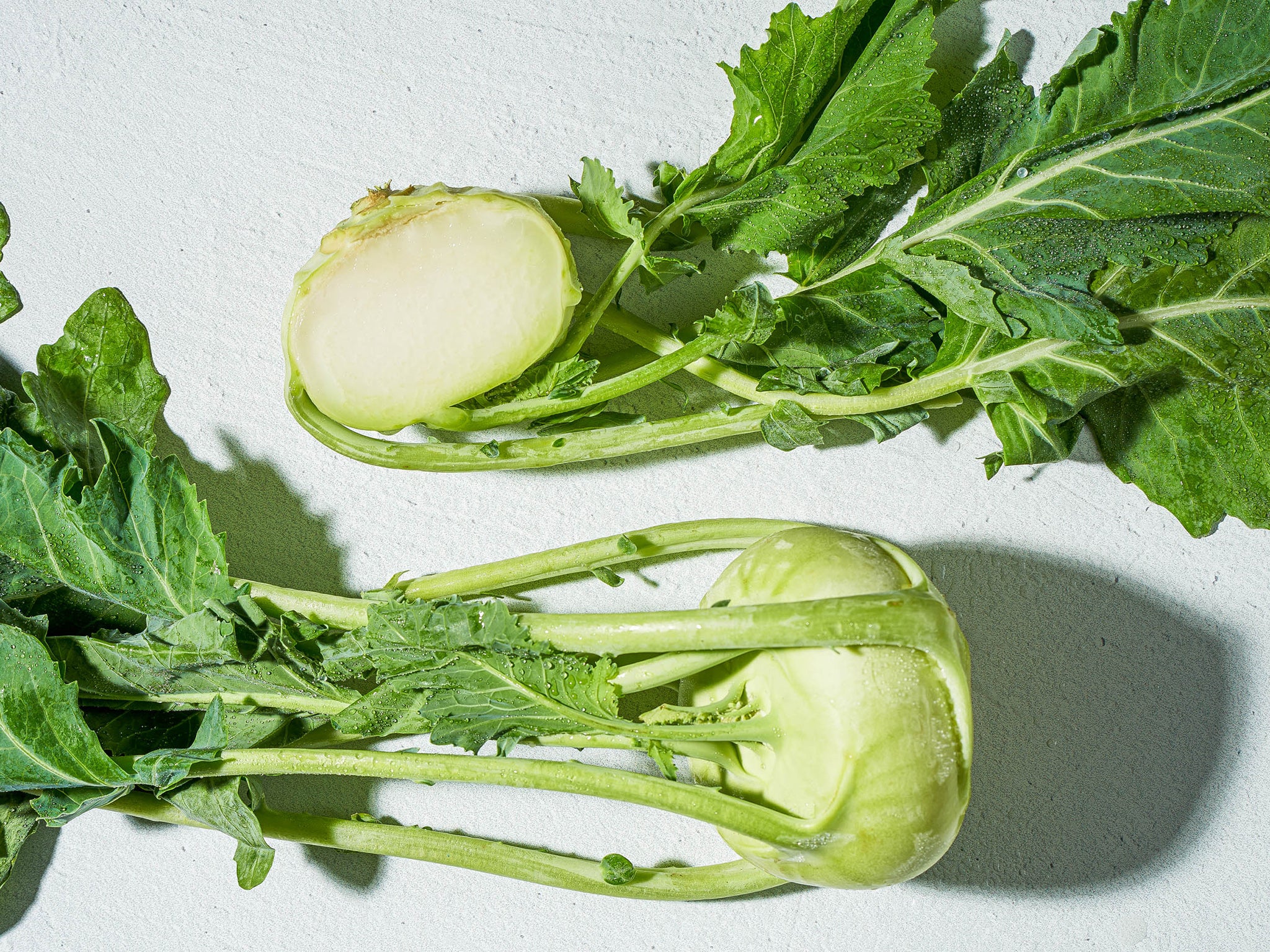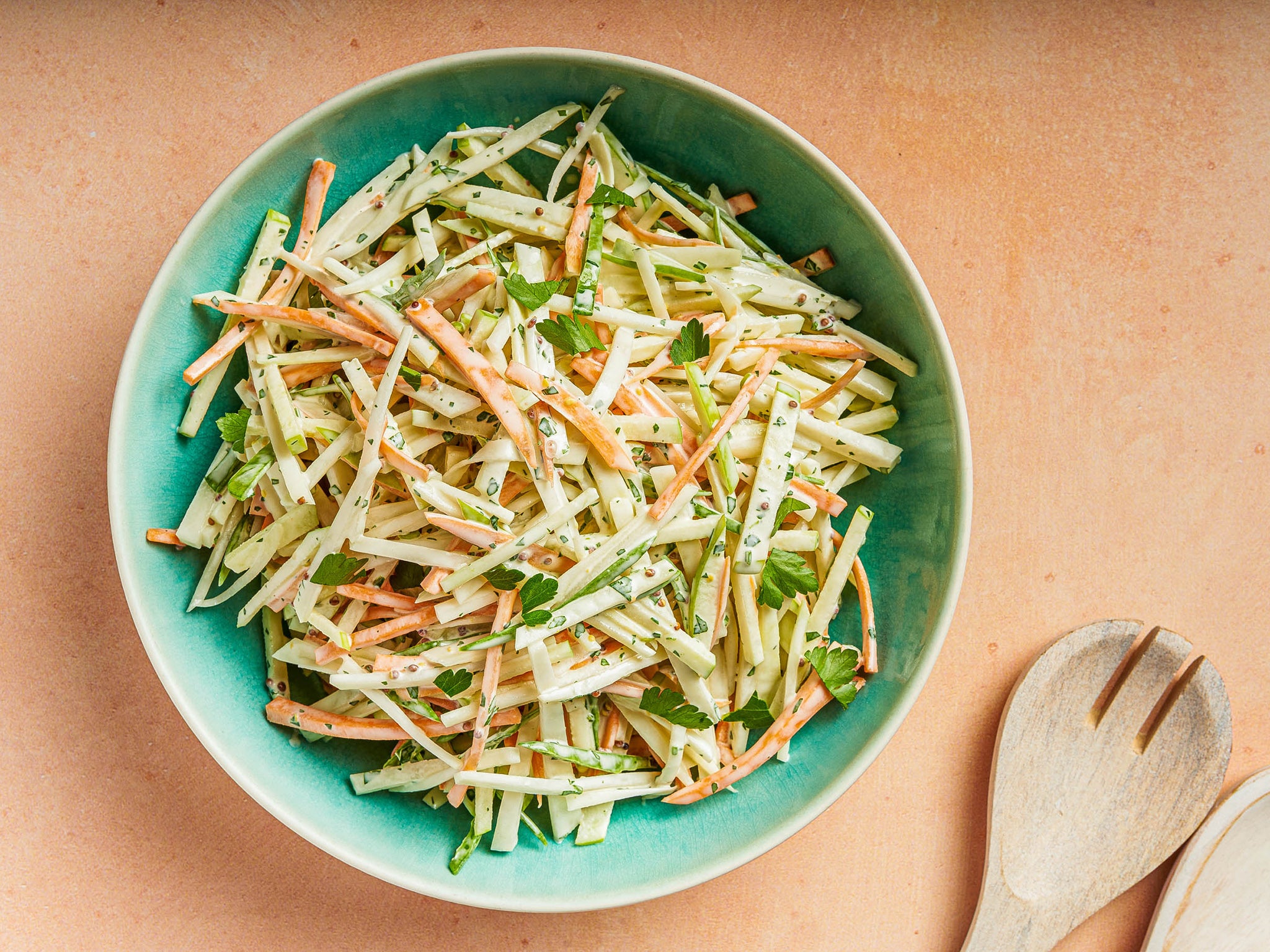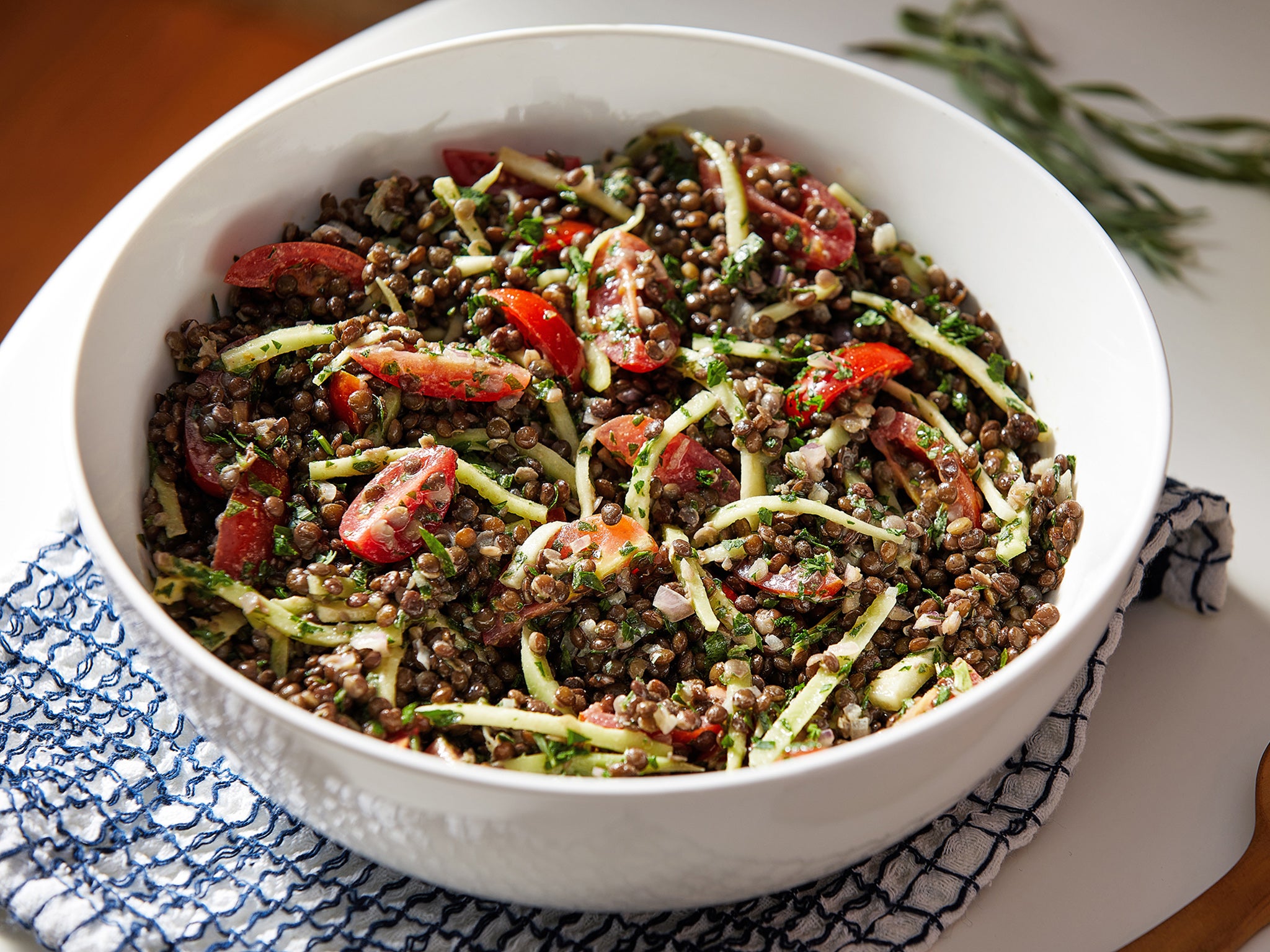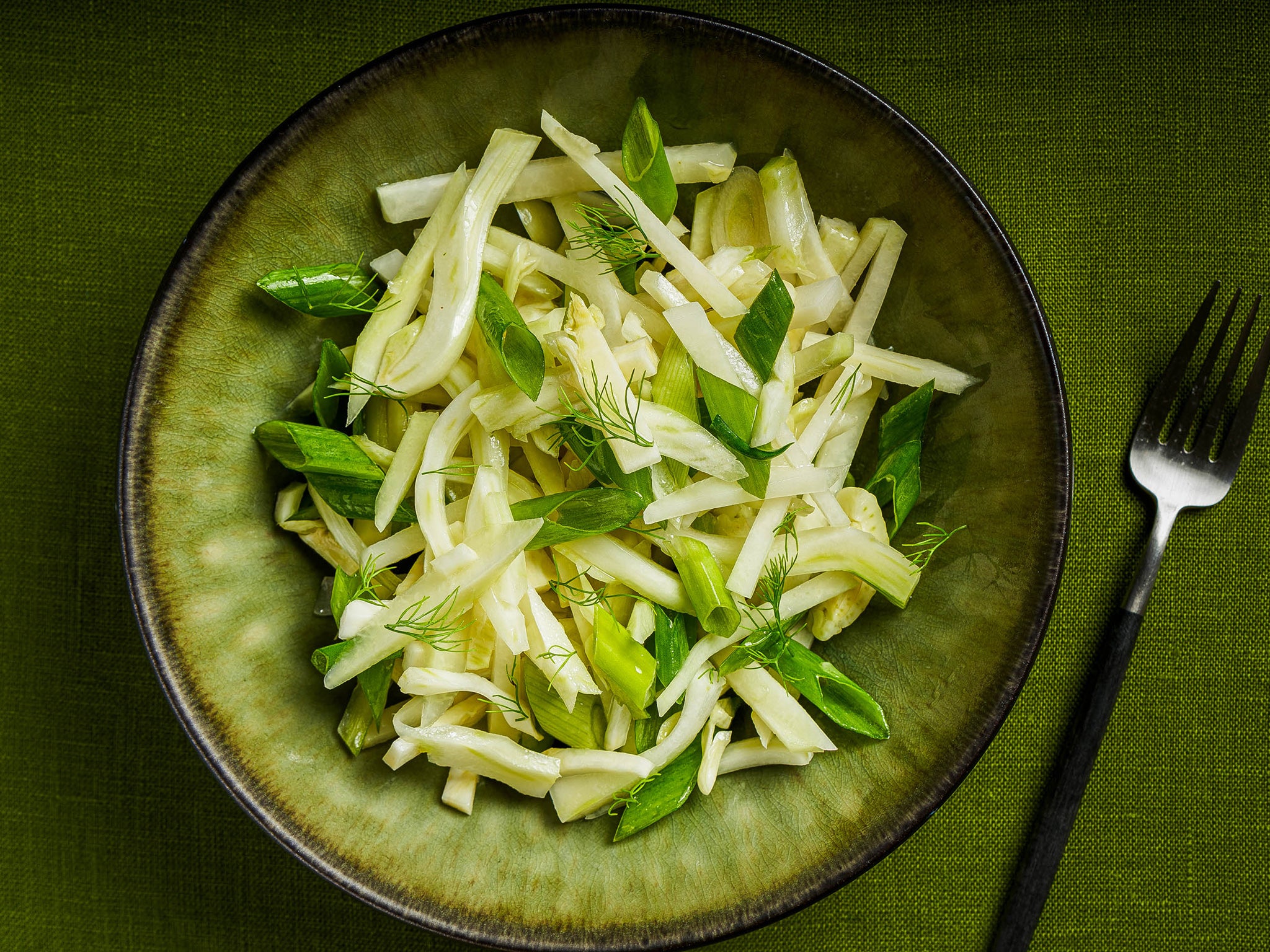How to cook kohlrabi
Don’t be put off by its gnarly appearance, says Aaron Hutcherson. One taste of kohlrabi and you might just fall in love

Pale green or purple, with leaves sprouting sporadically from the bulbous stem, kohlrabi looks like something you might find in the depths of the ocean or on another planet. It’s not a very popular vegetable, perhaps because of its gnarly appearance, but there’s no reason to be afraid if you come across it. One taste and you just might fall in love (I know I did).
Here’s what you need to know.
Kohlrabi is a word borrowed from German that is a mash-up of kohl (cabbage) and rübe (turnip). While the flavour reminds me of a turnip – very mild with the ever-so-slightest hint of sweetness – it is not a root vegetable. The bulb is actually the stem of the plant that grows above ground. Instead of a root, it is a cruciferous vegetable, like Brussels sprouts, cabbage and broccoli (it is often compared to broccoli stems).
If you’re in the market for kohlrabi and they’re not foisted upon you in a produce box, you want to stay away from those with blemishes or wilted leaves. (Raw or cooked, the leaves can be eaten too!) Look for smaller bulbs – with a diameter up to 3 inches – as they can become woody when larger. Like cabbage, kohlrabi should be stored in the crisper drawer of the refrigerator where it can last for weeks. If the leaves are attached, you’ll want to separate them from the bulb and they should be used within a couple of days.
Before enjoying kohlrabi, be sure to remove the tough, fibrous outer layer with a knife. The smaller, more tender bulbs are most often eaten raw in slaws, salads and as crudité to take advantage of their satisfying crunch (I found myself munching on them like carrots for a snack). Save the larger bulbs for cooking – they can be grilled, mashed, roasted, fried, sauteed, etc – so you can soften the tougher flesh.
Kohlrabi’s neutral taste means it’s versatile enough to go into just about any savoury dish you can think of. But if you’re looking for a head start, here are a few recipes that put kohlrabi to good use.
Kohlrabi and apple salad

Serves: 6-8
Kohlrabi tastes sweeter and milder than most cabbages. It assimilates the flavour of whatever is incorporated into the recipe and can be cooked like a potato: boiled, steamed or roasted, mashed, creamed and buttered, but most people have it either raw or slightly sauteed.
Choose small kohlrabi “bulbs” to serve raw; save the large bulbs for recipes in which the vegetable is treated like a potato. Either size should be peeled; the skin can be stringy and tough.
This salad goes well with barbecued ribs and a Belgian white beer.
Make ahead: The salad can be assembled and refrigerated up to 3 days in advance.
Ingredients:
80g non-fat plain Greek-style yoghurt, such as Chobani brand
75g olive-oil mayonnaise
Juice of 1 large lemon (2 tbsp)
1 tbsp coarse-grained mustard
½ tsp granulated sugar (optional, especially if the apple is sweet and juicy)
Leaves from 3 large sprigs flat-leaf parsley, finely chopped (2 tbsp), plus a few sprigs for garnish
680g (3 medium) kohlrabi bulbs (peeled), cut crosswise and then cut into very thin strips (julienne; if the leaves are still on the kohrabi bulbs; reserve for another use, such as adding to sauteed greens)
2 medium carrots, scrubbed and julienned
1 handful (about 10) snow peas (strings discarded), julienned
1 medium Granny Smith apple, peeled, cored and julienned
Method:
In a large bowl, whisk together the yoghurt, mayonnaise, lemon juice, mustard, sugar, if using, and chopped parsley until combined.
Add the kohlrabi, carrots, snow peas and apple, and mix well to coat evenly. Let sit at room temperature for a few minutes to let all the flavours meld.
Garnish with parsley sprigs and serve.
Black lentil salad with vegetables and herbs

Serves: 6
In this salad, matchsticks of kohlrabi or broccoli stems add pale, crisp contrast to tender, caviar-like black lentils, along with juicy grape tomatoes, shallot and herbs, all coated in a rich mustard vinaigrette. It makes a stunning side for a cookout and can also serve as a vegan main course.
The salad can be refrigerated for up to 3 days in an airtight container.
Kohlrabi is most easily found at farmers markets.
The lentils can be cooked and refrigerated in an airtight container for up to 4 days.
Ingredients:
180g black beluga lentils
3 tbsp extra-virgin olive oil
1 tbsp fresh lemon juice
2 tsp Dijon mustard
½ tsp coarse salt
½ tsp freshly ground black pepper
2 medium bulbs kohlrabi or broccoli stems from one head of broccoli, tough skins removed, cut in to thin matchsticks
200g plum tomatoes, quartered
30g chopped fresh flat-leaf parsley
2 tbsp very finely chopped shallot
1 tbsp chopped fresh tarragon or 1 tsp dried
Method:
Bring 950ml of water to a boil in a medium pot.
Meanwhile, rinse the lentils and sort through them to remove any stones that may be present. Stir the lentils into the boiling water, reduce the heat to medium-low and simmer until they are just tender, 20 to 25 minutes. Drain and transfer to the refrigerator to cool completely, about 1 hour.
Once the lentils are cool, in a small bowl, whisk together the oil, lemon juice, mustard, salt and pepper.
In a large bowl, combine the lentils with the kohlrabi, tomatoes, parsley, shallot and tarragon. Drizzle the salad with the dressing and toss to combine. Serve at room temperature or chilled.
Fennel and kohlrabi salad

Serves: 6
This crisp, fresh-tasting side dish can be made 2 to 3 hours ahead and refrigerated. Toss again before serving. A mandoline will do the best job of cutting the vegetables paper-thin. The recipe doubles easily.
Ingredients:
3 medium kohlrabi, peeled, halved and very thinly sliced
3 large bulbs fennel, trimmed, halved and very thinly sliced
1 bunch spring onions, white and light-green parts, cut on the diagonal into 1½cm slices
Juice from 3 large lemons
60ml canola oil or other neutral oil
Fine salt
Method:
In a large bowl, toss together the kohlrabi, fennel, spring onions, lemon juice and oil until combined. Season to taste with salt and serve right away or chilled.
© The Washington Post
Join our commenting forum
Join thought-provoking conversations, follow other Independent readers and see their replies
Comments
Bookmark popover
Removed from bookmarks